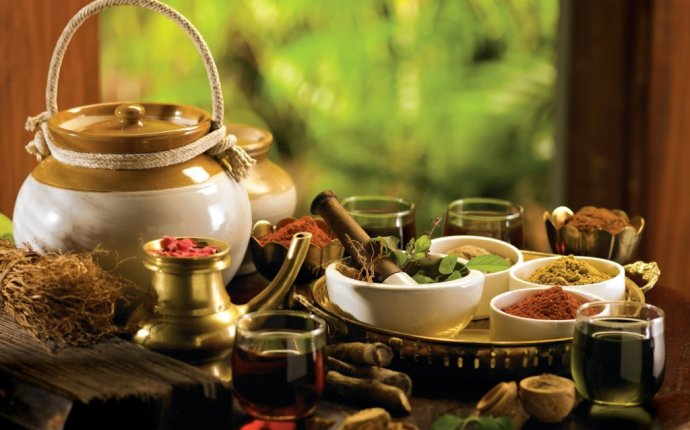
Ayurvedic Beauty Care
Step 1: Your External Skincare Routine for Glowing Skin
Are you ready for your ayurvedic makeover? The following skincare routine was designed by ayurvedic experts Pratima Raichur (an ayurvedic consultant and the author of Absolute Beauty) and Melanie Sachs (the author of Ayurvedic Beauty Care). In a perfect world, she says, you should work with an ayurvedic beauty professional who can custom-tailor a program to your specific needs (or, at the very least, try taking a dosha quiz , an ayurvedic skin analysis quiz and consulting ayurvedic books with body-mind beauty practices suited to your prakriti, or constitution). In the meantime, you can experiment with these tips and homemade recipes from our favorite experts. They’re safe for men, women, and children of all skin types.
Full-Body Skincare
Ayurveda outlines three steps to beautiful skin: cleanse, nourish, and moisturize. If that sounds like standard operating procedure in the West, think again. While Americans use soap to cleanse the skin, Raichur (a chemist by trade) writes that such products “dry the skin and alter its pH balance, causing it to become more alkaline.” As a result, we reach for synthetic moisturizing creams, “which can be too dense on the molecular level to permeate the tissue adequately.” Instead, ayurveda suggests using ubtans (pastes made from herbs, flours, and legumes) to cleanse and exfoliate the skin, and then nourishing and moisturizing with organic unrefined oils.
Ayurveda outlines three steps to beautiful skin: cleanse, nourish, and moisturize.Raichur recommends the following recipe for full-body skincare. Try doing it daily; according to Raichur, “the skin sheds cells at the rate of a million per hour, ” so it is important to remove those cells on a regular basis.
To cleanse
Make an ubtan by mixing equal parts chickpea flour (a gentle natural exfoliant) and dry milk powder (which is nourishing for the skin) in a jar. Sprinkle 2 teaspoons into the palm of your hand, add water to make a thin paste, and scrub lightly over wet skin in the shower. Rinse off and pat dry.
To nourish & moisturize
Make a body oil by mixing 1 ounce of almond oil with 10 drops of essential oil appropriate to your prakriti: for dry “vata” skin, use sweet orange or geranium; for sensitive “pitta” skin, jasmine or sandalwood; for oily “kapha” skin, lavender or bergamot.
Warm your bottle of oil in hot water for a few minutes, and then prepare to give yourself an abhyanga (self-massage with oil). For an introductory practice, Raichur recommends the following: Pour some oil on your palm and massage your scalp, the tops and bottoms of your feet, and the rest of your body, including your abdomen and spine. Use long repetitive strokes along your limbs and circular strokes on your joints and scalp. “As you anoint yourself with the oil, ” she says, “reflect on the fact that the word for oil in Sanskrit, sneha, is also the word for love. So this self-massage ritual is essentially spreading love and nourishment to all of the tissues in your body, as well as to your mind and senses.”
According to the Charaka Samhita, abhyanga pacifies the doshas, enhances the complexion and the luster of the skin, tones muscles, and acts as a natural moisturizer. For these reasons, Raichur explains, ayurvedic body massage is “one of the most effective means of slowing the skin’s aging process…. It works to purify, nourish, and tone the body on a deep cellular level.”
Facial Care
The same principles—cleanse, nourish, and moisturize—apply to facial care. You can tailor your regimen to your prakriti by reading instructions in ayurvedic beauty books, or try this simple, five-minute routine recommended by Melanie Sachs, author of Ayurvedic Beauty Care.
- Bathe your face thoroughly with warm water. “Dead skin cells will soak up the water like little sponges and plump up, which makes them easy to remove, ” she says.
- Make an ubtan with 2 tablespoons of oat flour and 1 tablespoon of water. Bend over the sink, dip your second, third, and fourth fingertips into the ubtan, and gently press the paste onto your face. This removes the dead skin cells without stripping the skin of its natural oils.
- Put some plain water or rose water in a spray bottle and spritz the face a few times to moisten the skin.
- While the face is still wet, apply a thin coating of jojoba oil to seal in the moisture. According to Sachs, jojoba oil is closest to the skin’s sebum; as a result, it is highly unlikely to cause irritation.
Step 2: Your Internal Routine for Glowing Skin
Ayurvedic beauty experts agree: To cultivate glowing skin and a sense of inner balance, design a dinacharya (daily routine) with the following health-boosting activities. (These are basic guidelines; to tailor a program to your particular needs, consult a qualified ayurvedic practitioner.)
Diet
In general, ayurveda recommends a healthy, whole foods, largely vegetarian diet for all types of constitutions. Raichur says that fatty, fried, refined, and processed foods, salt, sugar, seafood, and red meat can cause skin problems—so avoid them when you can.
Exercise & Sleep Hygiene
Ayurvedic experts suggest exercising at least five times a week until sweat forms along the spine and under the arms. Exercise promotes sweating (which rids the body of toxins), increases circulation, and calms the mind.














